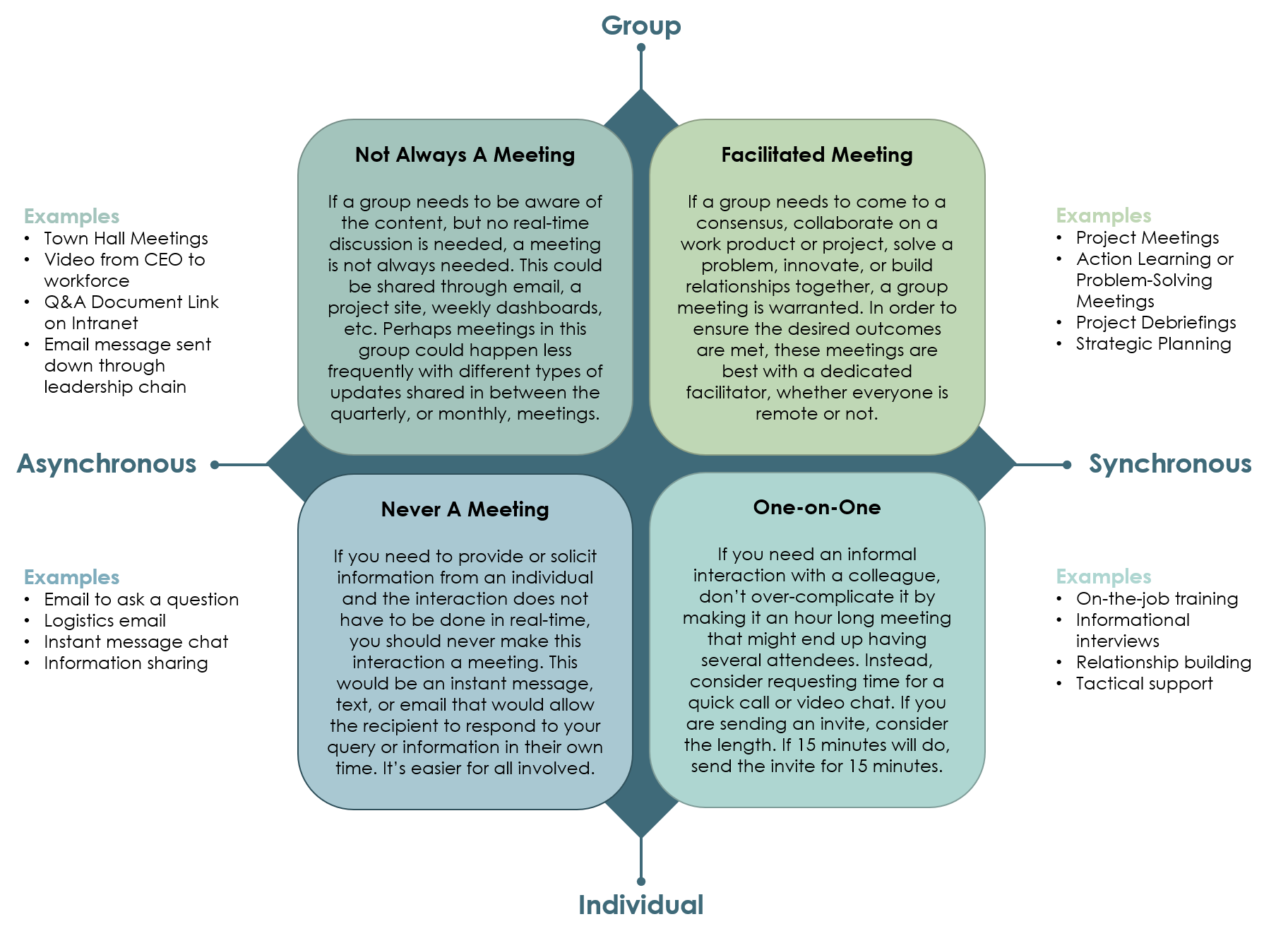Meetings are a necessary evil, especially when working remotely.
Or are they?
I was talking to a friend and colleague the other day. We were commiserating about how every interaction we had in the office is now a meeting with dozens of attendees.
Every stopping by a desk to chat… is now an hour-long video call.
Every meeting for coffee… is now an hour-long video call.
Every bumping into someone by chance in the hallway… is now an hour-long video call.
Every quick brainstorming or kibitzing session… is now an hour-long video call.
And… we felt like we were being meeting-ed to death before everyone went remote in response to the pandemic!
It’s not that it doesn’t make sense. We all work in our own little worlds with no “incidental” interaction with the people we work with.
How many times have you been in the office and happened to overhear something that was critical knowledge for your work? Or bumped into someone who shared something you should have already known?
Those incidental interactions in the office can be critical to providing you with the context you need to do your job.
When working remotely, the fear of missing out is more than a hashtag popular 15 years ago. A common problem in remote teams is that communication drops off a cliff, and nobody is getting the information they need. But we will leave that topic for another day.
If you have an onslaught of daily meetings, your coworkers recognize that informal communication in an office environment needs to be deliberate in a remote work environment.
It is absolutely a good thing that the people you work with understand that communication sharing needs to be deliberate. It can, however, be a little overwhelming when the only deliberate communication tool being used is the meeting.
Does every interaction in a remote work environment need to be a formal meeting?
Get the Context & Information you Need
I don’t know if you are anything like me, but when there is a void of information, I tend to make assumptions and make up stories to explain that void. I’ve seen the same thing in many of my coaching clients.
For example, I sent an email to a valued colleague the other week. I rely on this colleague for guidance, reality checks, and feedback… all very important things. He is always so responsive to me. When we talk to each other on the phone, we always end the call energized and full of ideas. But, the other week, I sent an email to touch base and ask a question. Crickets.
It didn’t take long for my brain to start creating stories to explain the change. Boy, oh boy, every self-doubt I had hidden in my brain made its way out into why my friend wasn’t responding to my message.
- You’ve worn out your welcome.
- He’s been adding much more value than you provide him.
- You did or said something that pissed him off.
- He was in a terrible accident and hospitalized somewhere.
- He was swamped with work – why isn’t he asking for my help? I owe him so much…
And on and on…
It took everything I had to avoid following up repeatedly after my initial email based on the stories in my head. I did follow up a week later because it was so out of the norm for him I was concerned.
The truth was that he was so burnt out that he disconnected for a week and simply forgot to call me beforehand and give me a heads up. He was so apologetic afterward about going silent without warning.
He, of course, did not owe me an apology. He works so hard and deserves to take some tech-free days off without getting my approval.
But, it was an example of how our brains will fill the void when there is a lack of communication.
How does this relate to remote work?
Well… when we are all in the office together, there are all kinds of “incidental” communication channels. Those channels disappear when we all start working remotely.
There are no more meetings after the meeting.
There are no more water cooler conversations.
There are no more quick chats as you pass people in the halls or swap conference rooms at the top of the hour.
It doesn’t take long for the remote worker to feel out of the loop.
Being out of the loop does two things, and neither is good.
First, you get inflicted with my “fill the void” disease I described above. Your brain starts filling in the context where needed. This leads to miscommunication. Reading tone into an email that is not there. Making assumptions and inferences that are misguided. Creating conflicts that aren’t based on reality.
Second, the organizational context you organically obtained when in the office is no longer readily available. That organizational context is important for decision-making and innovation in the organization. It is a key component of productivity.
So, the question is: How do we re-create the incidental communication that is so important in an office environment when we are in a remote work environment?
I asked several people who have been highly effective, high-performing remote employees for years that exact question. Here were their top three suggestions:
#1: Ask to be added to relevant meetings
None of us want to sign up for more meetings – this whole blog post is about how to AVOID meetings. However, the remote-working gurus I spoke to saw these meetings differently.
These were not meetings where they had to pay close attention or contribute significantly. They spent most of the meeting multitasking and completing other simple tasks on their to-do list. But, the meeting was on in the background, and they could pay more attention if needed. They could listen to topics that were relevant to their work. They could learn what others were doing.
For example, one of the people I spoke to was a leader in administration and operations for a business line. One of her responsibilities meant she worked closely with the Human Resource office. She asked to be on the HR weekly team meeting as an optional attendee. This meant she could listen to the HR meeting when she didn’t have a conflict, received all of the meeting minutes and presentations (whether she attended or not), and could provide context around any HR changes or updates that would impact the business line, most of the time before HR had formally communicated out a change.
It is a proactive tactic that can certainly pay dividends.
#2: Pick up the phone
This was almost universal with everyone I surveyed about this question. They never got themselves into a back-and-forth email chain. If things couldn’t be completely resolved with one (maybe two) emails, they picked up the phone and had a conversation.
This was especially true with problem-solving. If they were being asked to help resolve an issue and couldn’t send an email simply saying the issue had been resolved, they picked up the phone and asked the questions they needed to ask, trying to solve the problem in real-time, if possible.
But, it wasn’t just for problem-solving. Trying to find a date for a meeting, and it is going back and forth? Pick up the phone. Trying to resolve a misunderstanding? Pick up the phone.
Relationships are so important to those who have been working remotely for years. The most important thing is to preserve the relationship, no matter the topic. And the best way to do that is to pick up the phone.
#3: Read all the blast emails
This tip will make all of the internal communications people very happy. Most organizations have various blast emails that go out regularly. They can be newsletters, all of the company’s mentions in the news, all sorts of things.
Someone is being paid money to compile, write, edit, and send out those messages. Somebody important thinks those messages are important.
Yet, most organizations are lucky to get more than a 25% open rate on those emails.
Be one of the 25%. The veteran remote employees mentioned how these emails were part of their weekly or daily routine. Those emails are a great brain break from the more intense knowledge work on your to-do list. You can read them on your walk around the block at lunchtime.
Reading these emails is an easy way to get the organizational context that someone has spent time and effort to curate for you.
Hopefully, I have convinced you that you must be deliberate in your communications, especially in remote work environments. Look at how you have shared the context people need to learn from you. How could you better share that context (preferably without additional meetings)?
Communicate Effectively
We, humans, are visual communicators.
Much like the Galapagos Great Frigate Bird, who will blow up its bright red throat pouch (body language) and squawk loudly (tone) to communicate its purpose of the moment, most of our communication has nothing to do with the words being said.
For us, 55% of communication is body language, and 38% is the tone of voice. When we use email, we miss out on 93% of our communication ability.
Using the phone is a little better. We have the words we speak and our tone of voice, so communicating by phone is 45% effective.
Both of those are important modes of communication. But, when you are taking the time to get people together in a meeting remotely, if video is an option, you should use it.
Use Video Every Time
I know we are not sitting around in our home offices camera ready. I can’t tell you how many executives I have met with over the past several months who were wearing graphic tees or other things they would never be caught dead in the office wearing. I think it adds an element that helps build relationships. Don’t back away from it.
I am almost always in a messy bun because it keeps the hair out of my face, and I don’t have to do anything to it. I call it my “telework hair.” Embrace it and turn on your video.
When we use video, we get all three aspects of communication – body language, tone, and words – for the opportunity of 100% effective communication.
Be Straightforward (but not too straightforward)
When we are communicating in person, we have everything I just mentioned – tone and body language – to help us get our message and intent across. So, we can use those things to insert sarcasm, a double entendre, euphemisms, puns, jokes, and more to align our message to our personality and send subtle messages that we don’t have to say out loud.
For instance, I don’t have to say anything for you to know if I like the snack you shared or not. Especially if it is too salty, my face will say it all. I don’t have to say anything at all.
However, when removing a piece of our communication (like body language and/or tone), you must be very clear and explicit in your messaging.
You want to think about what you want the reader to feel, think, and do with your message, and craft your message accordingly.
The reader will insert his/her own tone when reading your message. So, you want to remove all of the personality flairs you might add in a face-to-face message.
If you need to send some constructive feedback, do not try to sugarcoat it. There is too much chance the message will get lost, and the reader will only absorb the sugar.
But, you also do not want to demoralize the person.
Let’s look at an example:
Let’s say I got a call from the Big Boss that a deliverable just sent out to the entire workforce had a fairly glaring typo. Let’s say my team member Sam was responsible for sending that out.
The first thing I do while on the phone with the Big Boss is to take responsibility for the mistake without throwing Sam under the bus.
The second thing is to reach out to Sam. How should I communicate with her? A video call would be best because the message has constructive feedback I need to share, and we may need to share screens, etc. But, I also don’t want to catch her off guard, so I send an email with a little information and ask her when we can catch up on video for 30 minutes.
The email does not need to be long or detailed. But, I want to give Sam a heads-up on the topic so she knows what is coming and that it needs to be addressed soon.
What do I want Sam to feel? I want her to feel conscientious, not mortified or demoralized.
What do I want Sam to think? I want her to think about how she can solve the problem and what can be done to prevent similar future errors.
What do I want Sam to do? I want her to take action today, to resolve the issue after we discuss the appropriate strategy.
Now that I’ve thought about that, it is time to draft a brief message to start the process:
Sam – I saw you sent out That Deliverable to the workforce today. Thanks so much for getting it out on the day you promised.
I just got notified that there were some errors that neither you nor I caught before it went out. I want to set up 30 minutes to have a video call with you today so we can strategize about the next steps.
Does 2 PM ET work for you? We can use my meeting link <<link>>. Thanks!
The first two sentences recognize Sam’s effort.
The third sentence gives Sam a heads up that not everything was perfect while also sharing responsibility so she knows I’m not going to throw her under the bus for an error anyone could have made.
The fourth sentence clearly states that this needs to be resolved today and that we will work together to solve the problem. This hopefully puts her in that problem-solving mode.
The final sentence is a tactical sentence to ensure we meet today.
Anything more brutal than this would probably demoralize Sam.
I would write a very similar email whether Sam was a superstar and this was a rare occurrence for her or if Sam was someone I was actively working with to improve her performance.
The message can be similar because Sam will put her own tone on my words based on her other contexts.
Try it for yourself.
Pretend that you are Superstar Sam and read the message. How did you feel? What did you think? Is it clear what you need to do?
Now, pretend you are Unsaitisfactory Sam and read the same message. How did you feel? What did you think? Is it clear what you need to do?
What you felt and thought were likely different, depending on which Sam you were pretending to be.
Use Visuals
One of the things I learned while going to school was that I was a very visual and kinetic learner. If I attended the lectures, could see the slides or other material while I listened and had a chance to talk about it myself or do something to drive the information into my brain, I rarely had to study outside of class.
However, some of my MBA classes were online in the early days of online learning. The class consisted of reading the lecture, reading the readings, then having a written discussion with classmates on the discussion board.
That didn’t work for me.
I wasn’t learning anything.
I found three other people in the class who were local to my area. We met each week to host a class within the class. We all had to read everything but focus on a specific area that we would then “teach” to everyone else.
That’s more like it.
I could skim everything, read my section, and prepare visuals and materials to teach others my topic. Preparing the visuals helped me better understand the information, and listening to the others explain the visuals they created helped me understand that information.
Especially when we are all remote, visuals give the listener something to focus on. Even if it is just a bulleted list of topics to cover, something to focus on in addition to your face seems to add to the depth of the meeting. It also means that you are thoroughly covering all of the learning and communication styles in your meeting.
Don’t get me wrong.
I’m not suggesting death by PowerPoint. But, a bulleted topic list or a 2X2 framework (like below) can work wonders to support your words in getting your message across.
What can you implement today that would increase the effectiveness of your communication? Perhaps if you could communicate effectively without always needing a big meeting, you could reduce the number of meetings you have to attend each day.
Decide When Things are Worthy of a Meeting
When I worked within a large organization, I was a member of the leadership group from all over the country that got together in person quarterly for what were supposedly strategic meetings.
When I first started attending these meetings, they were the worst 3 days of my quarter. They were not strategic meetings. It was like a roll call meeting where each leader of a portfolio or region (basically, the owners of all profit and loss (P&L) statements) reported their quarterly updates.
Each of the 20 executives would spend 40 minutes to an hour talking about every minute detail of their business. Their financial numbers, strengths, weakness, opportunities, threats, etc.
Yawn.
If you think about the hourly rate of all the people sitting in the room and the fact that these 20 people spent 3 full business days together, including travel costs…
We were looking at a mid-six-figure expense each quarter for what ultimately could (should) have been shared via email in a quarterly report.
I ultimately convinced the leadership group that the format was ridiculous. They were all as miserable as I was. I convinced them to change the format. The weekly calls we had would be used to share short updates as needed and talk about the tactical things that popped up in the course of doing business.
The quarterly meetings were going to be truly strategic. We were going to tie the four meetings annually into the strategic planning cycle and tackle tough strategic decisions in the meetings where we take the time and money to come together in one location.
Things improved immediately. The value of the meeting became clear. Leadership looked forward to the meetings instead of dreading them.
The moral of this story is that having meetings to cover topics that don’t justify the meeting can be costly. In my example above, the quarterly meetings cost over $1M annually without accomplishing anything. More than the cost, it was causing our senior leadership team to become disengaged, and we missed the opportunity to tackle strategic issues that needed our attention.
This one bad meeting had significant financial, morale, and lost opportunity costs.
6 Types of Meetings
When you Google “meeting types and their purpose,” a blog post from MeetingSift is the highlighted response, highlighting six general types of meetings.
- Status Update Meetings
- Information Sharing Meetings
- Decision-Making Meetings
- Problem-Solving Meetings
- Innovation Meetings
- Team Building Meetings
I’m sure that if we put our heads together, we could come up with several other types of meetings that do not fall into one of the six categories above, especially when discussing a remote work environment.
Instead of going through each type of meeting individually and inevitably leaving something out, I thought I would go over three things you should consider when determining whether your needs elevate to needing a meeting or not.
Purpose of Meeting
The first thing to consider is the purpose of the meeting. In my leadership meeting example, the stated purpose was to provide strategic direction for the organization. That certainly deserves a meeting.
However, in executing those meetings, the purpose in practice was information dissemination. There is no need to have a meeting to disseminate information, not when so many other options exist to accomplish the same thing.
So, when thinking about your meetings, think about the purpose of the meeting and whether a meeting is the best format for that purpose.
Group versus Individual
The next thing to think about is whether you need to engage one or two individuals or whether you need to engage a large group.
This factor alone does not determine whether a meeting is needed, but it is an important element to consider.
What tends to happen in some organizations is that when a meeting is on the books for a specific topic, the attendee list tends to grow. If your need is to meet with one or two individuals and the meeting grows to a couple of dozen, the dynamic of the meeting has changed dramatically and is no longer suited for your original purpose.
Synchronous versus Asynchronous
This was the problem of the leadership meeting I described above, they were spending synchronous time covering information that should have been distributed asynchronously.
With the meeting types listed above, the status update and information sharing meetings should almost always be asynchronous. However, getting together to explicitly make decisions, solve problems, innovate, or build relationships is a good reason to get together in a meeting.
These questions will hopefully help you evaluate whether or not a meeting is needed. You can also use the 2X2 described below to audit the meetings already on your calendar and see if you could switch some of those meetings to asynchronous information-sharing opportunities to reclaim some of your days.
Audit Your Calendar
 This graphic is a simple 2X2 that puts two of the elements discussed above on the horizontal and vertical axes.
This graphic is a simple 2X2 that puts two of the elements discussed above on the horizontal and vertical axes.
Most things on the left side of the chart will not require a meeting. Sometimes, if the group is the entire workforce and the information is important, a meeting format like a Town Hall might make the most sense. However, for the most part, meetings are unnecessary if the information or content can be shared in a way other than real-time.
Most things on the right side of the chart will require a meeting of some sort. However, think of the purpose and other information, like length and number of participants, to ensure you can accomplish the intended purpose.
Do you typically have a calendar full of meetings every week?
If so, you may want to take a moment and use this framework for auditing your calendar over the next week and answering the following questions:
Which meetings are a mismatch?
Who is the owner of that meeting?
Can you decline or suggest an alternative?
What meetings do you own that you could accomplish differently?
How can you share context with your team without needing to talk to everyone in a meeting?
Hopefully, you will find a few meetings that can change formats to allow people to interact with the content asynchronously.
If not, if you are in a job that just has meetings as a part of your life, hopefully, the information included in this blog can help you improve the meetings so that the purpose of the meeting is achieved by the time the meeting is over.
Nothing is more demoralizing than spending all day in meetings, knowing that most meetings never came close to achieving their stated goal.
Conclusion
You aren’t alone.
If it makes you feel any better, thousands of people are suffering through a needless meeting with you at any given time.
However, you can make a difference in your organization.
You can be the liberator for all of your colleagues by taking action.
You do not have to be the boss. And you do not have to ask questions in a confrontational way. Just start encouraging your colleagues to think about when a meeting is the best option… and when it is not.
Lead by example by using the 2X2 framework above when trying to connect and share information with, or retrieve information from, your colleagues. Heck, share this blog post if you think it will help!
Imagine a workweek where every meeting you were in was productive, AND you had the time out of meetings you needed to get work done too…
You have all of the simple tools you need to make a huge difference in your calendar and the calendar of everyone else in your organization.
So, go forth and reclaim your calendar!
P.S. Auditing the meetings on your calendar is only one way to improve your productivity. If you are interested in learning more about improving the productivity of your remote teams, along with lots of other free resources, you should join our free Change Collaborative community. You can learn more here.





